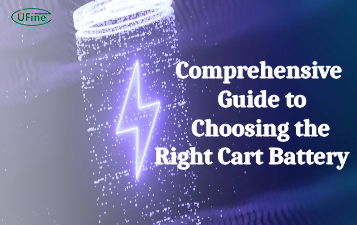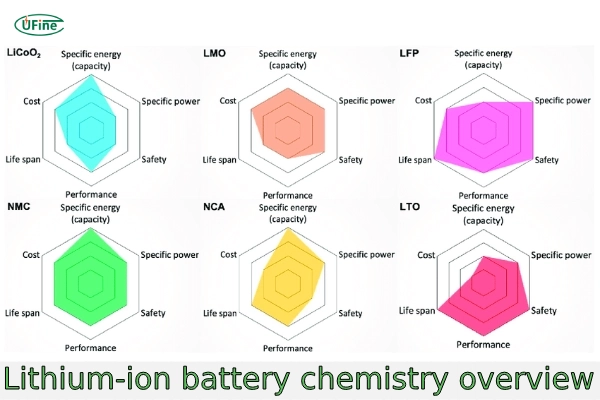Are you curious about the various types of lithium-ion battery chemistry? In this article, we’ll explore the fundamental differences between them. What are the key distinctions between lithium-ion battery chemistries, and how do they impact performance? Let’s delve into the factors that influence the choice of lithium-ion battery chemistry. Lastly, what are the future trends and developments in lithium-ion battery chemistries? Join us as we uncover the exciting advancements in this field!
Part 1. Lithium-ion battery chemistry overview
1. Lithium Cobalt Oxide (LiCoO2)
Lithium Cobalt Oxide, commonly known as LiCoO2, is a prevalent type of lithium-ion battery chemistry. It consists of lithium ions intercalated with cobalt oxide layers.
- Characteristics: LiCoO2 offers high energy density, making it suitable for long-lasting power applications. It also exhibits good conductivity and stable cycling performance.
- Advantages: LiCoO2 batteries have a high specific energy, providing more energy storage per unit weight than other chemistries. They frequently power portable electronics like smartphones and laptops.
- Limitations: However, LiCoO2 batteries are prone to thermal runaway and have a limited lifespan. Additionally, cobalt is expensive and subject to supply chain challenges.
2. Lithium Manganese Oxide (LiMn2O4)
Lithium Manganese Oxide, or LiMn2O4, is another widely used lithium-ion battery chemistry. It comprises lithium ions combined with manganese oxide.
- Characteristics: LiMn2O4 batteries offer good thermal stability and safety features. They also have a lower cost compared to cobalt-based chemistries.
- Advantages: LiMn2O4 batteries are environmentally friendly and have a relatively long cycle life. You commonly find them in power tools, electric bicycles, and medical devices.
- Limitations: However, LiMn2O4 batteries have lower energy density than cobalt-based chemistries, reducing capacity and range for electric vehicles.
3. Lithium Iron Phosphate (LiFePO4)
Lithium Iron Phosphate, known as LiFePO4, is recognized for its exceptional safety and longevity. It consists of lithium ions bonded with iron phosphate.
- Characteristics: LiFePO4 batteries have excellent thermal stability and are highly resistant to thermal runaway, making them one of the safest lithium-ion chemistries.
- Advantages: LiFePO4 batteries have a long cycle life, making them ideal for applications requiring frequent charging and discharging cycles. People commonly use them in electric vehicles, solar energy storage systems, and backup power solutions.
- Limitations: However, LiFePO4 batteries have a lower specific energy than other chemistries, resulting in larger and heavier battery packs for the same energy storage capacity.
4. Lithium Nickel Manganese Cobalt Oxide (LiNiMnCoO2 or NMC)
Lithium Nickel Manganese Cobalt Oxide, abbreviated as NMC, is a versatile lithium-ion battery chemistry that combines nickel, manganese, and cobalt oxides.
- Characteristics: NMC batteries offer a balanced combination of high energy density, power capability, and thermal stability.
- Advantages: Various applications, including electric vehicles, grid energy storage, and consumer electronics, use NMC batteries for their excellent overall performance and cost-effectiveness.
- Limitations: However, NMC batteries may experience capacity fade and thermal instability at high temperatures, requiring careful thermal management during operation.
5. Lithium Nickel Cobalt Aluminum Oxide (LiNiCoAlO2 or NCA)
Lithium Nickel Cobalt Aluminum Oxide, or NCA, is a high-energy lithium-ion battery chemistry incorporating nickel, cobalt, and aluminum oxides.
- Characteristics: NCA batteries offer high energy density and excellent power capability, making them suitable for electric vehicles and high-performance consumer electronics.
- Advantages: NCA batteries provide long driving ranges for electric vehicles and enable fast charging capabilities due to their high power density.
- Limitations: However, NCA batteries are more prone to thermal runaway than other chemistries, necessitating robust thermal management systems in battery packs.
6. Lithium Titanate (Li4Ti5O12)
Lithium Titanate, often abbreviated as LTO, is a unique lithium-ion battery chemistry that utilizes lithium titanate as the active material.
- Characteristics: LTO batteries exhibit exceptional thermal stability, safety, and longevity, even under extreme conditions.
- Advantages: LTO batteries offer ultra-fast charging capabilities and an extended cycle life of over 10,000 cycles, making them ideal for demanding applications such as electric buses, energy storage systems, and grid stabilization.
- Limitations: LTO batteries have a lower energy density than other lithium-ion chemistries, resulting in larger and heavier battery packs for the same energy storage capacity.
Part 2. Comparison of lithium-ion battery chemistries
1. Energy Density
- Lithium Cobalt Oxide (LiCoO2) is Known for its high energy density, making it ideal for compact electronic devices.
- Lithium Manganese Oxide (LiMn2O4) offers moderate energy density, suitable for applications prioritizing cost-effectiveness over high energy density.
- Lithium Iron Phosphate (LiFePO4) Provides lower energy density than other chemistries but offers enhanced safety and longer cycle life.
- Lithium Nickel Manganese Cobalt Oxide (LiNiMnCoO2 or NMC) Balances high energy density with good power capability, making it suitable for electric vehicles and energy storage systems.
- Lithium Nickel Cobalt Aluminum Oxide (LiNiCoAlO2 or NCA) Offers high energy density. It is particularly suited for applications requiring high performance and compact size.
- Lithium Titanate (Li4Ti5O12) Provides lower energy density but compensates with fast charging capability and long cycle life.
2. Safety and Stability
- Lithium Cobalt Oxide (LiCoO2) is prone to thermal runaway and is less stable under high temperatures.
- Lithium Manganese Oxide (LiMn2O4) is Known for its good thermal stability and reduced risk of thermal runaway.
- Lithium Iron Phosphate (LiFePO4) Offers excellent thermal and chemical stability, minimizing the risk of overheating and fire hazards.
- Lithium Nickel Manganese Cobalt Oxide (LiNiMnCoO2 or NMC) Provides moderate stability and safety features compared to other chemistries.
- Lithium Nickel Cobalt Aluminum Oxide (LiNiCoAlO2 or NCA) Offers good thermal stability but may exhibit safety concerns under abusive conditions.
- Lithium Titanate (Li4Ti5O12) is Known for its exceptional thermal stability and safety features.
3. Cycle Life
- Lithium Cobalt Oxide (LiCoO2) Offers a moderate cycle life of around 300-500 cycles, suitable for consumer electronics with typical usage patterns.
- Lithium Manganese Oxide (LiMn2O4) Provides a cycle life ranging from 500-1000 cycles, depending on operating conditions and depth of discharge.
- Lithium Iron Phosphate (LiFePO4) is Known for its long cycle life, typically exceeding 2000 cycles, making it ideal for applications requiring frequent charging and discharging.
- Lithium Nickel Manganese Cobalt Oxide (LiNiMnCoO2 or NMC) Offers a cycle life ranging from 1000-2000 cycles, balancing energy density with longevity.
- Lithium Nickel Cobalt Aluminum Oxide (LiNiCoAlO2 or NCA) Provides a cycle life similar to NMC, ranging from 1000-2000 cycles. But it may degrade faster under high temperature or high voltage conditions.
- Lithium Titanate (Li4Ti5O12) Offers an exceptionally long cycle life of over 10,000 cycles, suitable for applications demanding prolonged usage and frequent cycling.
4. Cost
- Lithium Cobalt Oxide (LiCoO2) is relatively expensive due to cobalt’s high cost and limited availability.
- Lithium Manganese Oxide (LiMn2O4) Offers a cost-effective alternative to other chemistries and is particularly suitable for mass-market applications.
- Lithium Iron Phosphate (LiFePO4) Provides good value for its enhanced safety and long cycle life despite being slightly more expensive than some alternatives.
- Lithium Nickel Manganese Cobalt Oxide (LiNiMnCoO2 or NMC) Moderate cost, balancing performance with affordability.
- Lithium Nickel Cobalt Aluminum Oxide (LiNiCoAlO2 or NCA) is relatively expensive due to the use of cobalt and aluminum but offers high performance for specific applications.
- Lithium Titanate (Li4Ti5O12) is Typically more expensive than other chemistries due to its advanced features and manufacturing processes.
Part 3. Factors to consider when choosing lithium-ion battery chemistry
When selecting a lithium-ion battery chemistry for your application, you should consider several factors:
1. Energy Requirements:
Consider the energy density required for your application. High-energy-density chemistries like Lithium Cobalt Oxide (LiCoO2) are suitable for compact devices, while lower energy densities like Lithium Iron Phosphate (LiFePO4) offer enhanced safety and longevity.
2. Safety Considerations:
Evaluate the safety features of each chemistry, including thermal stability and risk of thermal runaway. Chemistries like Lithium Iron Phosphate (LiFePO4) offer excellent thermal stability, making them suitable for high-demand and safety-critical applications.
3. Cycle Life:
Assess the cycle life needed for your application. Chemistries like Lithium Titanate (Li4Ti5O12) offer exceptionally long cycle life, making them ideal for applications requiring frequent charging and discharging.
4. Cost:
Consider the cost-effectiveness of each chemistry, including initial investment and long-term maintenance. While some chemistries may have higher upfront costs, they offer better value in longevity and performance over time.
5. Application Specifics:
Evaluate how each chemistry aligns with the specific requirements of your application, including temperature range, discharge rates, and environmental factors. Choose a chemistry best suits your application’s optimal performance and reliability needs.
Part 4. FAQs
-
What is the difference between Lithium Cobalt Oxide (LiCoO2) and Lithium Iron Phosphate (LiFePO4)?
LiCoO2 offers high energy density, which is ideal for small devices but less safe. LiFePO4 is safer and has a longer cycle life, making it perfect for electric vehicles and storage systems. -
Why is cycle life meaningful when choosing a battery chemistry?
Cycle life measures how often a battery can charge and discharge before it loses capacity. Longer cycle life means fewer replacements, saving money, and reducing waste. -
Are lithium-ion batteries safe?
Yes, especially with chemistries like LiFePO4, which have excellent thermal stability. Proper use and storage enhance the safety of all lithium-ion batteries. -
How does temperature affect lithium-ion batteries?
High temperatures shorten battery life, and low temperatures reduce capacity. LiFePO4 and Li4Ti5O12 are more stable across temperature ranges. -
What is the future of lithium-ion battery technology?
Expect higher energy density, better safety, longer cycle life, and lower costs. Sustainable materials and integration with renewable energy will drive future developments.
Related Tags:
More Articles

Comprehensive Guide to Choosing the Right Cart Battery
Choosing the right cart battery ensures optimal performance and longevity. This guide covers cart battery types and helps you make an informed choice.
The Ultimate Guide to 18650 Button Top Battery
18650 button top batteries are popular for their high energy density and reliability. This guide covers their key features, usage, and maintenance tips.
The Power of Slim: Unveiling the Potential of Flat Lithium Ion Battery
Flat lithium-ion batteries power devices from phones to vehicles. This article explores their design, benefits, types, applications, charging, and safety.
The Comprehensive Guide to Battery Balancing and Battery Balancer
Battery balancing and balancers optimize performance, longevity, and safety. This guide covers techniques and tips for choosing the right balancer.
10 Key Facts About Drone Battery for 2024
Uncover crucial insights with "10 Key Facts About Drone Battery for 2024." Learn the latest trends and essential details on drone batteries.




